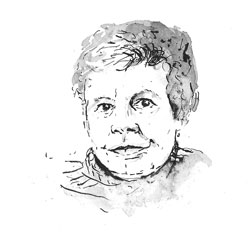Byatt: The Place of Poetry in Possession
The poetry in Possession is often structured like a series of Russian dolls nested inside one another. Poems introduce and end chapters, crop up in conversation or in the minds and letters of the characters. Here Laura Kilbride lists the places where poetry appears, and suggests some ways the embedded poems may be important.
This page contains a simple summary list, broken down chapter by chapter, of the poems that appear in Possession. This list is meant to work as a resource that leads to lots of particular reading suggestions. It's also the case that knowing more about the poems behind the novel will add to your understanding of the novel itself. Here are some questions to consider about the place of poetry in Possession:
- How does the location of each poem within the plot of the novel affect how it is meant to be received?
- How does the location of those chapters which are entirely poetry affect how we read the novel?
- Is it significant that certain chapters contain no poetry?
- What difference does it make when a poem appears as an , in comparison with when it is 'embedded' in the chapter? For example, is it easier to read the embedded texts because they are given a frame or a local context?
- How do the epigraphs guide our reading of each chapter?
- How do the characters in the novel read or use poems, and should we read in a similar way?
PREFATORY MATERIAL
Dedication to Isobel Armstrong (Literary critic specializing in nineteenth century poetry and women's writing, Professor at Birkbeck College, London).
Epigraphs: Nathaniel Hawthorne Preface to The House of the Seven Gables; Robert Browning's Mr Sludge, the Medium'.CHAPTER 1
Epigraph: Randolph Henry Ash (RHA), excerpt from The Garden of Proserpina.CHAPTER 2
Embedded: 'She Tells Her Love While Half Asleep' by Robert Graves.CHAPTER 3
Epigraph: RHA short excerpt from Ragnarök III.
Embedded (within Roland's consciousness) 'Finding out Ancient Battles from the Shards'.CHAPTER 4
Epigraph: Christabel LaMotte (CLM) 'The Thicket is Thorny'.
Embedded poems: 'I Like Things Clean About Me' (CLM, embedded in Veronica Hamilton's Criticism, where it is compared to George Herbert); 'From So Botched and Cramped a Creature' (CLM, insect poems); 'The One about the Cumaean Sibyl' (CLM, in Maud and Roland's conversation); Fergus Wolf quotes W.B. Yeats, 'For Anne Gregory', with reference to Maud's hair.CHAPTER 5
Epigraph: RHA, from The Incarcerated Sorceress.
Embedded: Excerpt from Tennyson's 'The Lady of Shalott' ('On either side the river lie...', embedded in Roland's consciousness); CLM's epitaph on the tombstone; CLM 'Dolly keeps a secret / Safer than a friend'.CHAPTER 6
Epigraph: RHA, The Great Collector.CHAPTER 7
Epigraph: CLM 'Men may be martyred / Any where'.
Embedded: in Beatrice Nest's narrative, RHA, 'We two remake our world by naming it'; CLM's Melusine in Ellen Ash's Journal.CHAPTER 8
Epigraph: CLM, 'All Day snow fell'.
Embedded: CLM, fragment from The Drowned City (in Roland's reading, prefaced by a note by Leonora Stern); CLM (?), 'And in the pool two fishes play" (in Maud's thoughts by the fishpond).CHAPTER 9
Embedded: CLM, poems / riddles in the fairytale 'The Threshold'CHAPTER 10
Embedded: CLM, 'Metamorphosis' and 'Psyche' (both enclosed within correspondence to RHA); fragments of poetry within the letters, the language of which might often be deemed 'poetic'; John Donne 'A : Forbidding Mourning', to which CLM responds in 'The grassy knoll / Shivers in his embrace'.CHAPTER 11
Whole Chapter: RHA, Swammerdam.CHAPTER 12
Epigraph: CLM, 'What is a House? / So strong - so square...'
Embedded: RHA's note, with the brooch to Ellen, transcribed in Ellen Ash's Journal ('I love a paradox and so I send'); RHA / CLM compared in the conversation of Roland and Maud.CHAPTER 13
Epigraph: RHA, Ragnarök IICHAPTER 14
Epigraph: RHA, from Ask to Embla, XIII.
Embedded: RHA quoting Wordsworth in a letter to Ellen, 'Mark! How all things swerve...' from 'Monastery of Old Bangor' in the Ecclesiastical Sonnets; Maud quotes the beginning of CLM, Melusina.CHAPTER 15
Epigraph RHA, 'And is love then more/ Than the kick galvanic'
Embedded: RHA quotes Troilus and Cressida by William Shakespeare before the consummation.CHAPTER 16
Whole Chapter: CLM, The Fairy Melusine, Proem.CHAPTER 17
Embedded: John Donne's 'Love's Alchemy' as the source for RHA's Mummy Possest (in Blackadder's footnote).CHAPTER 18
Epigraph: CLM, 'Gloves lie together/ Limp and Calm'.CHAPTER 19
Epigraph: CLM, From The City of Is.
Embedded (or, more accurately, Epilogues): CLM, 'Our Lady- bearing- Pain' (sent by Ariane Le Minier to Maud Bailey).CHAPTER 20
Epigraph: CLM, 'I press my palms on / Window's White Cross'.
Embedded: CLM quotes 'Faith' by George Herbert in a letter to Madame Cropper.CHAPTER 21
Whole Chapter: RHA, Mummy Possest.CHAPTER 22
CHAPTER 23
CHAPTER 24
No poems.CHAPTER 25
Embedded: Ash's Epitaph (Cardinal Bembo's epitaph for Raphael), Ash reciting from John Donne's 'A Valediction Forbidding Mourning' on his deathbed ('Dull sublunary lovers' love).CHAPTER 26
Epigraph: RHA, from The Garden of Proserpina.CHAPTER 27
Epigraph: RHA, 'In Certain Moods We Eat Our Lives Away'.CHAPTER 28
Embedded: CLM, in her last letter to Ash, quotes Samson Agonistes by John Milton.POSTSCRIPT
Embedded: RHA asks his daughter if she knows the verse from The Garden of Proserpina.
Further Thinking
The questions at the top of this article invite you to consider the particulars of these extracts and allusions in this novel. You could also look at our 'Intertextuality' resource, and the case study there, to think about the ways in which one text takes from, or opens itself to, another. There you'll also find a guide to some other novels that interweave writings of various kinds into their fictions.
